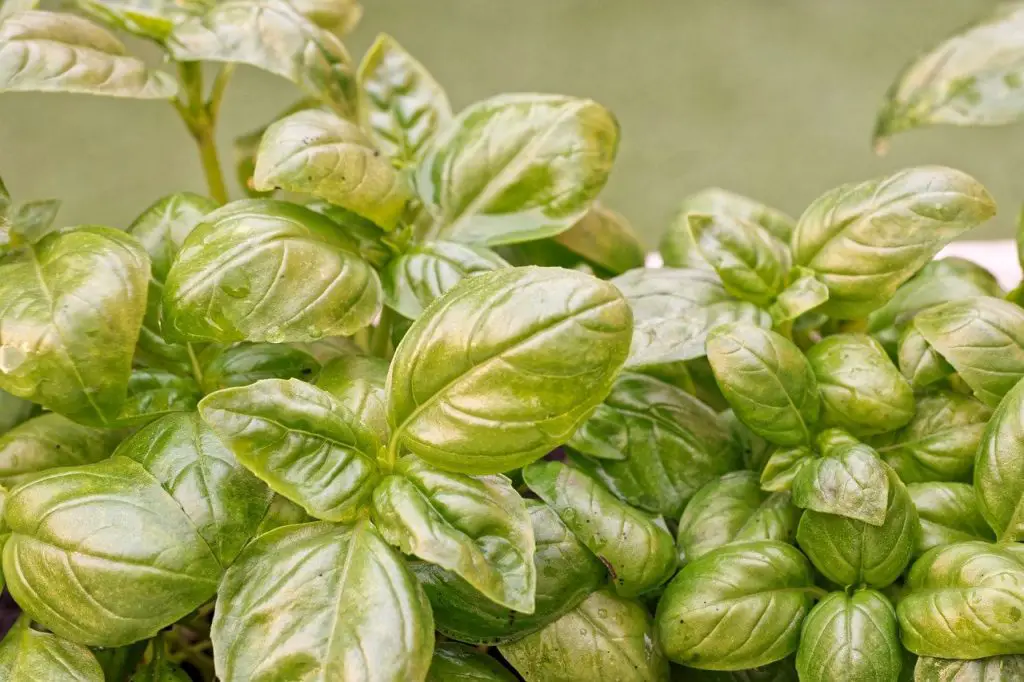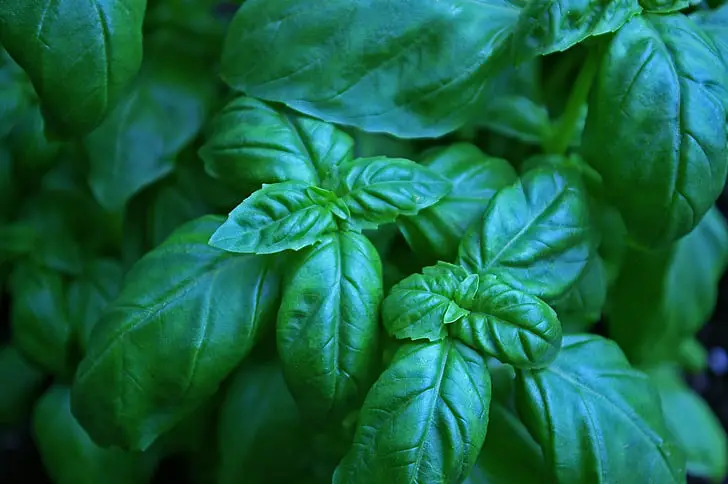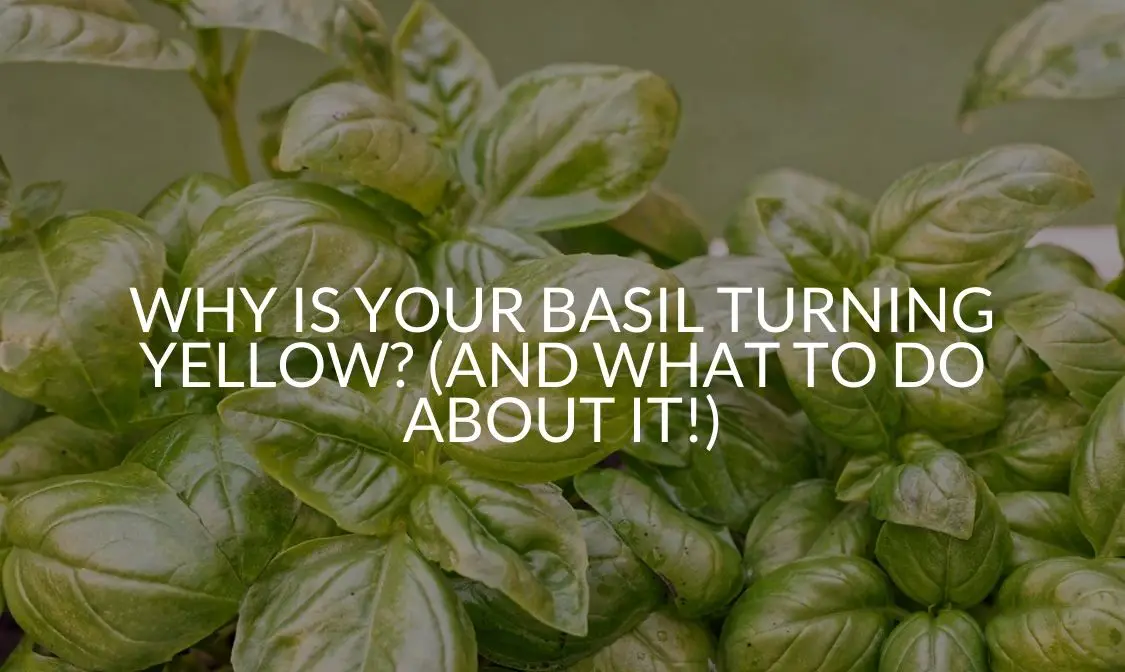Basil is a delicious culinary and beneficial healing herb that people have grown in their homes and gardens for centuries. It’s so versatile that it can grow as an annual or all year around. But it’s disheartening to see your basil’s leaves turning yellow. All those plans for tasty sauces and teas seem to slip away when this occurs.
So, why does this yellowing happen? How do you stop this and can you save the plant? Are the leaves still salvageable? As with most plants, there are a myriad of reasons why basil turns yellow. You can prevent and reverse the symptoms, but you must be sure of the cause.
What Causes Basil to Turn Yellow?
Almost all discoloration issues that happen with plants, like basil, are often a water or sunlight issue. But sometimes, it can be something more. Paying close attention and exercising scrutiny in observation is the only way to know for sure.
Watering Issues
Basil does much better with a little neglect, like it’s cousins Lavender, Mint and Rosemary. Because basil hails from the Mediterranean, it likes dry and arid conditions. If you overwater basil, the leaves will turn yellow from root rot. But underwatering can cause basil to turn yellow too. If the soil is dry with yellowed and wilted leaves but the leaves feel soft, the plant needs water.
So, it’s best to wait for signs of struggle and thirst before watering your basil. Make sure water goes into the base of the plant and ensure the leaves stay dry, but not dried up. Only give water to the plant when the topsoil is bone dry. Always err on the side of caution and water less than more.
Poor Soil & Nutrients
Basil is one of those plants that does very well in poor soil conditions, but it will still need to have a healthy amount of nutrients. If nutrients appear to be lacking, you may have to adjust the fertilizer or change up the soil. Check to assure the fertilizer is a quality, all-around mixture.
Conditions & Environment
Often, the reason why basil yellows is because of temperature, light and/or airflow. Basil needs six to eight hours of direct sunlight per day and be a general climactic temperature of no lower than 50°F at nighttime and 70°F or higher during the day.
If the plant is wintering indoors, it needs 10 to 12 hours of direct light per day. Additionally, if other plants are crowding the basil, it could be suffocating or choking. This can very much cause a yellowing of the leaves. Hardiness zones of 10 or higher can tolerate basil grown outside in your backyard garden. Anything less than that will not bode well for the basil.
Fungal Disease
Because of basil’s strict watering and environmental requirements, it can succumb to fungal diseases more easy than we’d like. The most common problem it experiences with fungus is Downy Mildew, which spreads very fast.
You can tell if the basil is suffering from Downy Mildew by the presence of yellow leaves accompanying fuzzy mousy-brown colored growth. You can stop the problem if you spot it early, but, if it spreads to most of the plant, you’ll have to toss it out.
EMF Exposure
Electromagnetic frequency waves (EMFs) from wireless routers, cellular towers and internet-connected devices, like tablets, smart phones and laptops, will affect basil if left next to it for too long. This includes any other Internet-of-Things devices like TVs and appliances. The yellowing and browning that can occur may not be recoverable if it’s too severe.
Pests & Infestations
Although pretty easy to grow, basil does have a propensity toward certain pests that can cause the leaves to turn yellow. Some of the most common culprits are aphids, spider mites, scales and caterpillars. If the infestation is bad, you will have to throw the plant away.
Aphids, Spider Mites ; Scales – Most insects will live on leaf undersides and where branches grow out from the stems and leaves. Some may even burrow their way into the roots. They suck nourishment from the foliage, causing basil to turn yellow.
Caterpillars – Caterpillars love feasting on basil leaves. And although this activity produces beautiful butterflies, it will cause your basil to turn yellow.
Root Knot Nematodes – Nematodes are soil-dwelling pests create small galls on the roots of the plant, causing basil to turn yellow.
What Can Cause Indoor Basil to Turn Yellow?
Basil grown indoors shouldn’t experience any pest infestations unless it sits outdoors in the warmer months. The most common problem of indoor basil is watering and lack of sunlight. If it’s wintertime, make sure it’s getting enough warmth too. Ensure it stays out of the path of breezes and freezing drafts.
It could be that your basil is receiving a constant barrage of electromagnetic frequency waves from your computer, smart phone or wireless internet router.

How to Stop Basil Turning Yellow?
To stop basil from turning yellow, take into account the plant’s growing conditions, including water, soil, fertilizer and light. You also want to inspect the plant for infestations, diseases, EMF distress and observing crowding from other plants.
If you’re looking for more preventative measures, try purchasing seeds of a species that is more resistant to problems like fungus and pests. Also, ensuring the soil is a sandy, loamy mix will help with drainage, which will mitigate watering issues.
Proper Evaluation
For most issues that arise with basil turning yellow, you can just clip away the bad parts and that should take care of the problem. But, if the plant is a disaster area of yellowed leaves, you may have to dispose of it.
Light, Temperature & EMFs
The first and easiest thing to start with is to look over it’s location. Monitor the sunlight coming in the window to observe whether the basil receives at least six to eight hours of light. For growing basil in zones less than 10, keep your basil in a pot so you can bring it in for the winter.
If your plant is next to your laptop, internet router or some other device, consider changing the situation. Either try to find a different location for your wireless contraptions or a separate sunny place for the basil.
Next, check the soil and make sure it’s dry and not overly moist. A regular fertilizer schedule should prevent any yellowing of your basil, even if the soil is less than desirable. If you notice the soil being too wet for too long, the roots may have already developed rot, in which case you’ll have to throw the basil out.
Overwatering & Underwatering
Overwatering problems are much more difficult to handle than underwatering ones. If it’s in a pot with a drainage dish, put a piece of clean cloth or paper towel between the pot and the dish. Make sure it gets a good airflow around it too. If you can, put a small oscillating fan nearby.
Check it once or twice a day, replace saturated cloth with fresh, dry ones as often as is necessary.
Underwatering issues should recover rather quick once it gets a little moisture. Moisten the soil every few days but only if you think it’s struggling. Other than that, do a deep watering every seven to 10 days, making sure there’s one good drainage hole on the bottom of potted basil.
Use your best judgment depending on the plants location, time of year and sun exposure. If it’s outside, sunny and very hot, make sure you give it a little more water than normal. But if it’s indoors with the least amount of sun, give it only a splash or two.
Fungal Control
If it’s a fungal disease, you want to be careful and wear gloves along with washing out the pot it was in. Check to see that the plant has enough airflow to avoid fungi growth. This is because fungus requires moisture to develop and encourages spore production. Being careful with the watering schedule is the best way to prevent fungal spores from killing your basil.
If you plan on growing lots of basil, plant them in rows parallel to the direction of the wind. This will speed drying, provide a continuous source of air and minimize rain damage. You can apply a fungicide to control disease but these aren’t a cure for it, only a preventive measure.
Pests & Infestations
If the soil checks out okay, but the leaves have this yellowed effect, inspect the leaves and soil. Be gentle and dig near the roots to see if there’s any rot, infestation or other unhealthy appearance. Look for any holes in the leaves, nodules around the stems and galls around the roots.
Using an insecticidal soap to spray on the leaves will remove most pest infestations. Exercise caution when doing this so the soapy water doesn’t burn or scorch the leaves in direct sunlight or on hot days. Never use the mixture over 90°F and make sure the sun is in the shade or it’s nearing sunset to apply it.
You can remove caterpillars by picking them off or using a natural bacterium like Bt (bacillus thuringiensis). But for root knot nematodes, you’re going to have to harvest the plant and save whatever healthy leaves are available. When you plant it again, ensure you use a more pest-resistant variety.

Frequently Asked Questions
Why Are Your Basil Leaves Turning Yellow And Curling?
When there’s a curl effect on the the leaves with yellowish discoloration, there are several factors that could be causing this:
Water – Water your basil plant on a regular basis but be sparing with it. Too much or too little water will cause the leaves to curl and turn yellow.
Disease – Aside from Downy Mildew, Fusarium is another fungal disease that can cause brownish, distorted leaves.
Infestation – Bugs and insects are often the cause of curling leaves with a yellowish discoloration.
Sunlight – If the basil isn’t receiving at least six hours of direct light during warmer months and 10 hours in the winter, it will develop a yellowed curling around the leaves.
Why Are Your Basil Leaves Turning Yellow With Brown Spots?
If you notice brown and black spots on the leaves, there could be a number of reasons for it. Cold, heat, sunburn, fungus, humidity, poor air circulation, infestation or EMF exposure could be the culprit – or a combination of these.
Before you take care of the problem you want to be certain sure of the issue if you hope to save it. More often than not, though, it’s going to be an infestation or a fungal disease.
Can You Use Yellow Basil Leaves?
Yes, you can harvest yellow basil leaves and use them for your cooking and healing purposes. But you want to make sure that the yellowing comes from problems like light and watering rather than pests and disease. If the latter is the case, avoid consuming the leaves.
Why Are Your Hydroponic Basil Leaves Turning Yellow?
Hydroponic basil issues are a little different than in the garden or a pot. This indicates a nutrition deficiency called “interveinal chlorosis.” This means all parts of the leaf, except the veins, is yellowing because it lacks things like iron and magnesium.
Caring for Your Basil Plant
Basil is generally a very tolerant, easy-to-grow plant that doesn’t come with many problems. But issues can and do happen that must be cared for as quickly as possible. Most problems that come with any plant, including basil, almost always have to do with watering or sunlight. But with basil, it can be susceptible to infestations a little more than others.
Always keep your eye on the plant and water as little as possible. Maintaining a dry yet nutrient-rich environment should prevent any yellowing. But in the event that it does, check the leaves and the soil if you think it’s more than light and moisture.



